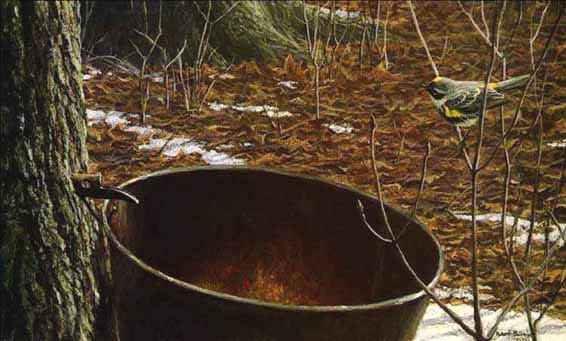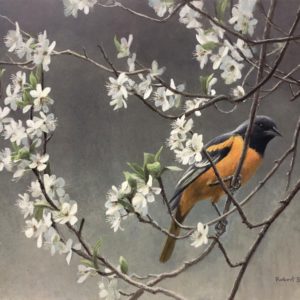Description
Sap Bucket Myrtle Warbler – 11-3/4 x 19-7/8; Offset Paper; Edition Size 950; $195.00 U.S.
“A particular pleasure of early spring was a visit to a sugar bush, a maple woodlot being tapped to make maple syrup. The sap begins to run when temperatures exceed freezing during the day then drop below freezing at night. In fact, this alternation between freeze and thaw is crucial to a good flow.
During my childhood, sap was still collected by traditional methods, in much the same way that native people had taught the early pioneers to harvest it. When the sap buckets were full, they were emptied into a gathering tank on a horse-drawn sled for transport to the sugarhouse, where the sap was evaporated in big pans over a constantly stoked wood fire. When I recall maple-sugaring time, I hear the snorting of horses and feel the crunch of last year’s leaves beneath the granular late-spring snow.
The warm spring sun shines through a barren tracery of branches, casting filigree shadow patterns on the ground. I know that in a few weeks the woods will come alive with wildflowers, but the only signs of life now are the running sap and perhaps an early returning migrant like a yellow-rumped warbler. Inside the sugar house arid wood smoke mixes with the sweet smell of maple vapors, reputed to be a sure-fire cure for a spring cold. Such memories evoke for me a simpler time, when communal labor was a regular part of most people’s lives.
…
Our ancestors evolved wonderful comprehensive systems for working gently with nature. They had to, because destroying nature would destroy the basis of the economy and even human life. In the late 20th century we have been under the illusion that modern technology can circumvent nature.
Maple syrup production is a good example of the gentle interface between traditional man and nature. With the right timing, the sap can be taken from sugar maple trees year after year. The sugar bush was an important part of the working farm. It not only provided maple syrup and sugar for family use and for sale, it was a perfect source of firewood in an age when heat was not provided by oil or electricity. The maple-beech-hemlock forest type is a climax stage. That is — the young trees can continue to grow in their parents’ shade and so the various species perpetuate themselves. As old trees are removed for firewood, the young trees are ready to replace them.
In this painting, I have shown a mature maple with its spile and traditional tin sap bucket. The warmth of the early spring sun is melting the snow and causing the sap to rise. The young maple seedlings are well established, some as saplings. Through the carpet of last autumn’s leaves, a spectacular array of spring flowers (trilliums, trout lilies, bloodroot and many others) are about to emerge. And the first of the migrant warblers to arrive is searching the area for early insects. The myrtle (yellow-rumped) warbler is a true harbinger of spring in the woodlot.”
Robert Bateman
Biography
Robert Bateman has been called the most famous living artist. He continues to paint and tour the world to promote conservation and preservation of nature. We have represented Robert Bateman for decades and are now the sole publisher and distributor of his reproductions. We are so honored to work with him and witness his success. He has made such a massive contribution to the art world and the natural world as an artist and educator of the earth’s most important resources.
Nature as a subject is becoming more and more popular as our environment is in peril. What better subject is there than the beautiful creatures we share this world with? Robert Bateman’s appreciation and understanding of nature are apparent in his paintings. He is able to paint flora and fauna the way your eye would perceive it in real life. It is important that the animal takes full attention. The background becomes muted, and therefore it doesn’t take too much focus away from the subject. His paintings seem effortless and masterful all at once.
Bateman’s eye for composition is unparalleled. Each painting is a composed like a symphony, leading the eye to wander. From the backyards of North America to the sprawling plains of Africa. Robert Bateman captures nature the way it should be enjoyed. Above all he is a champion of wildlife. For this reason he has become a household name for art collectors.


